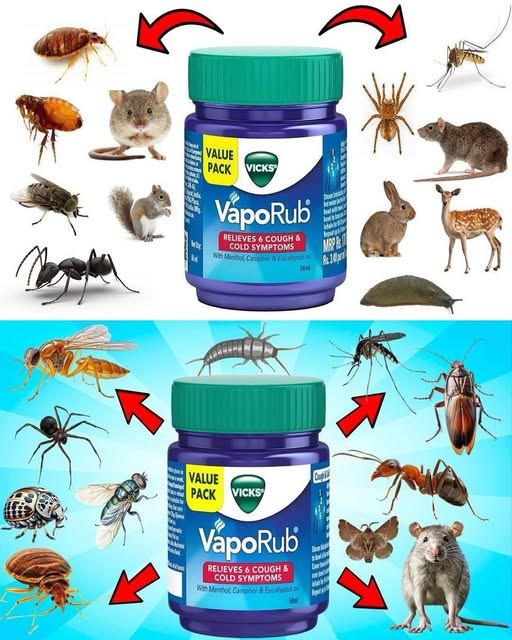If you’re tired of relying on harsh chemical sprays to keep pests out of your home, there’s a natural and surprisingly effective solution that you might already have tucked away in your medicine cabinet: mentholated ointment, such as Vicks VapoRub. This powerful balm combines a blend of menthol, camphor, eucalyptus oil, and cedar leaf oil, creating a strong, fragrant scent that pests find overwhelming. Beyond soothing colds and congestion, mentholated ointment works wonders as a chemical-free way to repel a variety of common household pests.

Whether you’re dealing with ants invading your kitchen, spiders creeping around your windowsills, or even rodents sneaking behind your cabinets, mentholated ointment offers a safe, budget-friendly way to reclaim your space naturally. Here are 13 clever ways to use this versatile product along with essential safety tips to ensure you protect your home effectively and responsibly.
The reason mentholated ointment is so effective lies in its scent profile. The powerful aroma of menthol, camphor, and other essential oils overwhelms pests’ sensitive senses, making your home a less inviting place for insects and rodents alike. Used correctly, mentholated ointment is non-toxic, affordable, and, with appropriate precautions, safe to use around pets and children. It’s ideal for use both inside your home and outdoors in your garden, making it a flexible solution for many common pest problems.
For mosquitoes, dab a small amount of mentholated ointment on your skin or place open jars near windows and beds to help keep these pesky insects at bay. For added protection, you can pair this method with a homemade mosquito trap for double defense. House flies can be discouraged by smearing ointment onto a cloth placed near sinks or trash cans, or by mixing it with warm water in a bowl and spraying around fly-prone areas. Be sure to refresh the application weekly to keep its potency strong.
Ants tend to enter homes through cracks and baseboards, so swabbing mentholated ointment along these areas and near trash bins can help keep them out. Reapply after cleaning for continuous protection. For spiders, rubbing the ointment along baseboards, windowsills, and near webs can deter them from settling in. Combining this with citrus-based sprays can further enhance your spider-fighting efforts.
Cockroaches dislike mentholated ointment and can be repelled by applying it behind appliances, inside pantries, or near trash areas. Be careful to avoid any direct contact with food surfaces. For mice and rats, soaking cotton balls with ointment and tucking them behind cabinets or near food storage areas can discourage these rodents. Remember to replace the cotton balls weekly and seal any entry points to keep these pests out for good.
Gnats can also be repelled by dabbing ointment on your skin and placing containers near fruit bowls. This not only deters gnats but also soothes existing bites. To combat bed bugs, apply mentholated ointment along mattress seams and frame edges and maintain a regular cleaning routine. Silverfish, which thrive in damp environments like sinks and tubs, can be targeted by mixing ointment with hot water and spraying near these areas. Make sure to keep these damp spaces well ventilated.
For moths, rub mentholated ointment onto cotton balls and place them in drawers or closets to protect your clothing. Refresh these cotton balls every two weeks to maintain their effectiveness. Beetles can be deterred by dabbing ointment on cracks and entry points, especially after storms or cleaning. Earwigs in garden beds can be kept at bay by rubbing ointment onto stakes or planter stems, and pairing it with natural powders like crushed pistachio shells boosts its power.
Wasps can be discouraged by applying ointment to outdoor furniture, under railings, or on eaves, but avoid applying it directly near active nests. As an added bonus, mentholated ointment can help deter fleas indoors by dabbing it on the corners of pet bedding or pet collars—but never apply it directly on your pet’s skin. To boost flea control, vacuum and wash pet areas regularly.
Safety should always come first when using mentholated ointment as a pest repellent. Avoid applying it directly to sensitive skin or near eyes, and keep it away from pets’ mouths, paws, and bedding unless a veterinarian has approved its use. Keep it out of reach of babies and toddlers under the age of two. Test it on fabrics or wood surfaces before wide application, as menthol can sometimes cause stains. Always use the ointment in well-ventilated areas and wash your hands thoroughly after handling to prevent irritation.
To maximize your results, clean surfaces before applying ointment to remove food residue and pest trails. Focus on common entry points such as baseboards, windows, and pipes to block pests where they enter your home. Consider layering your defenses by combining mentholated ointment with homemade traps and other natural repellents. Keep your routine consistent by refreshing applications weekly or as needed, and you can even add fragrance boosters to keep your home smelling fresh while remaining pest-free.
In summary, mentholated ointment is an easy, affordable, and highly effective natural trick for keeping pests at bay without harsh chemicals. It’s a simple way to protect your home, your family, and the environment. If you want a printable version of this guide or have your own pest-fighting hacks to share, just let me know—I’m here to help you keep your home peaceful, fresh, and pest-free!





